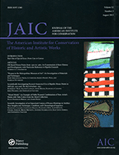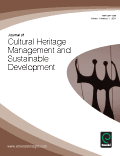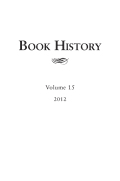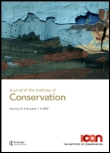
JOURNAL OF THE AMERICAN INSTITUTE FOR CONSERVATION
Scope & Guideline
Championing Excellence in Conservation Science.
Introduction
Aims and Scopes
- Interdisciplinary Conservation Techniques:
The journal emphasizes the integration of various scientific disciplines such as chemistry, physics, and materials science in the development and application of conservation techniques. - Preservation of Cultural Heritage:
A core aim is the preservation of diverse cultural artifacts, including paintings, sculptures, textiles, and historical documents, through innovative conservation methods. - Sustainability in Conservation:
The journal highlights sustainable practices in conservation, advocating for environmentally responsible methods and tools that minimize ecological impact. - Ethical Considerations in Conservation:
It addresses the ethical dimensions of conservation work, including the implications of treatment decisions and the importance of preserving the integrity of artifacts. - Education and Professional Development:
The journal serves as a resource for education and training within the conservation community, sharing insights on best practices, case studies, and advancements in conservation science.
Trending and Emerging
- Sustainability and Environmental Impact:
There is an increasing focus on sustainability tools and practices in conservation, reflecting a broader societal concern for environmental impact and the need for responsible stewardship of cultural heritage. - Diversity and Inclusion in Conservation:
Recent discussions emphasize the importance of diversity and inclusion within the conservation field, addressing systemic issues and advocating for broader representation in conservation practices. - Technical Innovation in Conservation:
The integration of advanced technologies, such as imaging techniques and material analysis, is becoming a key trend, enhancing the precision and effectiveness of conservation treatments. - Interdisciplinary Collaboration:
Emerging themes in conservation highlight the importance of collaboration across disciplines, such as art history, archaeology, and science, to enrich conservation practices and outcomes. - Contemporary Art Conservation:
There is a notable increase in research focused on the challenges and methodologies for conserving contemporary art, reflecting the evolving nature of artistic practices and materials.
Declining or Waning
- Traditional Conservation Methods:
There appears to be a reduced emphasis on traditional conservation methods, as the field shifts towards more innovative and scientifically rigorous approaches. - Historical Artifacts Conservation Exclusivity:
While historical artifacts remain important, there seems to be a declining focus on their conservation alone, with a growing interest in contemporary art and modern materials. - Generalized Ethical Frameworks:
Discussions around ethics are becoming more nuanced and specific, moving away from generalized ethical frameworks towards context-specific considerations in conservation practice.
Similar Journals

Revista Eletronica Ventilando Acervos
Connecting Researchers, Professionals, and StudentsRevista Eletronica Ventilando Acervos, with ISSN 2318-6062, is a pioneering academic journal published by the esteemed MUSEU VICTOR MEIRELLES-IBRAM, dedicated to the exploration and dissemination of research in the field of archival studies, museum studies, and heritage conservation. As an open-access journal, it provides unrestricted access to a wealth of scholarly articles, promoting the sharing of knowledge and innovative practices among researchers, professionals, and students alike. Situated in Florianópolis, Brazil, the journal not only showcases local research but also contributes to global discourse on cultural heritage and information management. With a vision to foster collaboration and dialogue within the academic community, Revista Eletronica Ventilando Acervos plays a pivotal role in enriching our understanding of archival science and its impact on society, making it an invaluable resource for anyone engaged in this dynamic field.

DENKMALPFLEGE
Elevating Standards in Conservation Practices.DENKMALPFLEGE is a prestigious journal published by DEUTSCHER KUNSTVERLAG GMBH, focusing on the field of cultural heritage conservation and restoration. With its ISSN 0947-031X and E-ISSN 2569-1589, this publication serves as an essential resource for researchers, professionals, and students dedicated to the preservation of historical monuments and sites. Although the journal does not currently offer open access, it provides a valuable wealth of scholarly articles, case studies, and reviews that critically engage with contemporary debates in conservation practices. Published in Munich, Germany, it bridges academic research with practical applications, underlining its importance in enhancing the discourse surrounding heritage preservation. Alongside its historical coverage from 2009 to 2012, DENKMALPFLEGE continues to be a vital platform for advancing knowledge in the field, promoting best practices, and fostering collaboration among experts.

Laboratorio de Arte
Bridging Disciplines in the World of ArtLaboratorio de Arte is an esteemed journal published by UNIV SEVILLA, EDITORIAL, specializing in the interdisciplinary fields of Arts and Humanities, Conservation, Museology, and Visual Arts. With an impactful presence in research since its inception, the journal has been open access since 2006, promoting the free dissemination of knowledge and fostering academic dialogue among scholars, professionals, and students. The journal adheres to rigorous academic standards, reflected in its categorization within the Q2 and Q3 quartiles across various disciplines, and its commendable rankings in Scopus make it an essential resource for those engaged in the arts. The h-index for this journal showcases its contribution to the field, further solidifying its importance in contemporary research. As it continues to evolve through 2023 and beyond, Laboratorio de Arte serves as a vital platform for innovative thoughts and practices within the vibrant landscape of artistic and cultural studies.

Loggia Arquitectura & Restauracion
Illuminating the Art of Restoration and Architectural IntegrityLoggia Arquitectura & Restauracion is a pivotal academic journal dedicated to the fields of architecture, conservation, and the visual arts, published by UNIV POLITECNICA VALENCIA, EDITORIAL UPV in Spain. With an ISSN of 1136-758X and an E-ISSN of 2444-1619, this Open Access journal has been providing a platform for scholarly discussions since 1996, enhancing the global dialogue on architectural methods and restoration practices. Boasting a Q3 ranking in both Architecture and Conservation, along with a Q2 ranking in Visual Arts and Performing Arts, the journal reflects a commitment to academic rigor and innovation, as it navigates the convergence of these important fields from 2019 to 2024. The research published in Loggia addresses critical contemporary issues, enriching the knowledge base for academics, practitioners, and students alike. With a current Scopus rank that situates it within the competitive landscape of arts and humanities, Loggia serves as a vital resource for those seeking to explore the intersection of culture, history, and sustainability in architectural practice.

Journal of Cultural Heritage Management and Sustainable Development
Exploring the nexus of heritage management and sustainable growth.Journal of Cultural Heritage Management and Sustainable Development is a pioneering publication dedicated to advancing the fields of cultural heritage management and sustainable practices. Published by Emerald Group Publishing Ltd in the United Kingdom, this journal has established itself as a critical resource since its inception in 2011, with an ongoing commitment to quality research through 2024. The journal is notably recognized with a Q1 ranking in Conservation and boasts impressive Scopus rankings, highlighting its significant impact in the realm of arts and humanities. It also showcases a multidisciplinary approach, bridging gaps between business management and urban studies, thereby providing invaluable insights to researchers, professionals, and students. With diverse access options to engage a broad audience, the Journal of Cultural Heritage Management and Sustainable Development thrives at the intersection of scholarship and practical application, making it an essential read for those dedicated to fostering sustainable development in cultural heritage contexts.

Book History
Illuminating the past through the lens of the written word.Book History is a pivotal academic journal published by Johns Hopkins University Press that delves into the rich and intricate narratives surrounding the book as a cultural artifact and form of communication. With its ISSN 1098-7371 and E-ISSN 1529-1499, this journal fosters interdisciplinary discourse across the fields of history, conservation, and library and information sciences, as evidenced by its solid standing in 2023’s Scopus rankings: 540th in Arts and Humanities (History), 48th in Arts and Humanities (Conservation), and 189th in Social Sciences (Library and Information Sciences). The journal operates under a Q2 ranking in History and Q3 in Conservation and Library and Information Sciences, making it a key resource for scholars and students alike. Dedicated to advancing the study of the book's multifaceted role in society from 2019 to 2023, it provides insightful research articles, reviews, and thematic explorations that contribute to our understanding of literary production, dissemination, and preservation. Although it does not provide open access options, its contributions are invaluable to the academy, enriching the scholarly conversation around books and their historical significance.

Conservar Patrimonio
Unveiling Insights for Heritage Preservation.Conservar Patrimonio is a leading academic journal dedicated to the fields of conservation and museology, published by the ASSOC PROFISSIONAL CONSERVADORES-RESTAURADORES PORTUGAL. Established as an open access platform since 2005, it aims to disseminate high-quality research and innovations essential for the preservation of cultural heritage. With an impressive 2023 impact factor, Conservar Patrimonio holds a Q2 ranking in Conservation and a Q1 ranking in Museology, reflecting its significant contribution to both disciplines. The journal is indexed amongst the top 30% of publications in the Museology category and offers valuable insights into the methodologies and practices that shape the conservation of cultural artifacts. Researchers, professionals, and students are encouraged to engage with the latest findings, case studies, and theoretical explorations presented in this esteemed journal based in Portugal, enhancing the global dialogue on conservation practices.

Intervencion-Revista Internacional de Conservacion Restauracion y Museologia
Connecting Scholars for a Sustainable Cultural Future.Intervencion-Revista Internacional de Conservacion Restauracion y Museologia is a prominent journal published by the Nacional Instituto de Antropología e Historia (INAH), focusing on the critical fields of conservation, restoration, and museology. With an ISSN of 2007-249X and E-ISSN 2448-5934, this journal serves as a vital platform for researchers, professionals, and students dedicated to the preservation of cultural heritage. Situated in Mexico, the journal aims to foster international collaboration and knowledge sharing in conservation practices and theoretical frameworks, supported by in-depth research and case studies. While the journal adopts a closed access model, its reputation continues to thrive, attracting contributions from respected scholars and practitioners globally. By integrating diverse perspectives on conservation strategies and museum studies, Intervencion significantly impacts the advancement of interdisciplinary methodologies in the heritage sector, making it an essential resource for anyone committed to the protection of cultural legacies.

Journal of the Institute of Conservation
Advancing Conservation Knowledge for a Sustainable FutureJournal of the Institute of Conservation is a leading academic journal dedicated to advancing the field of conservation, published by Routledge Journals, Taylor & Francis Ltd. With an impressive Q1 ranking in Conservation and a Scopus rank of #21 out of 103 in the Arts and Humanities category, this journal plays a pivotal role in disseminating high-quality research that shapes conservation practices and policies. Spanning the years from 2009 to 2024, it serves as a vital platform for scholars and practitioners alike, offering innovative perspectives on materials science, museology, and media technology. Accessible solely through institutional subscriptions, the journal invites contributions that engage with contemporary issues in conservation, ensuring that all articles foster interdisciplinary dialogue and enhance professional standards within the field. The Journal of the Institute of Conservation is thus essential for those committed to preserving our cultural and natural heritage.

METU Journal of the Faculty of Architecture
Unveiling contemporary architectural practices and theories.METU Journal of the Faculty of Architecture is a reputable academic publication dedicated to advancing research and discourse in the field of architecture. Published by MIDDLE EAST TECHNICAL UNIVERSITY in Turkey, this journal serves as a vital platform for scholars and practitioners, addressing both theoretical and practical topics relevant to contemporary architectural studies. With an impact factor that positions it in the Q3 category for architecture as of 2023, and a Scopus rank of #133 out of 189 in Engineering Architecture, the METU Journal is an influential resource for innovative ideas and studies. Encompassing a wide range of scholarly articles, it fosters academic collaboration between researchers and professionals, making it essential reading for anyone passionate about the evolution of architecture. Though not open access, it provides crucial insights and rigorous research from 2008 up until 2024, contributing significantly to the global discourse on architectural practices and theories.